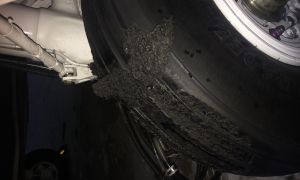Feeling Groovy?
- August
- 14
- 2017
- Advanced Aircrew Academy
The concept that a grooved runway surface, when wet, can be considered "effectively dry" was washed away for me one rainy day at South Bend, IN (KSBN). I had enough experience in my aircraft to know that a certain amount of brake pressure would yield a certain amount of deceleration on a dry runway. On this day, however, the anti-skid was going crazy with that level of brake pressure and got my attention. Fortunately, there is lots of runway at KSBN and everything was fine. Once I had a moment to reflect, I began to contemplate the possible reasons why I was not achieving the promised "effectively dry" performance the flight manual led me to expect.
The runway excursion landing overrun is statistically the highest accident threat for Transport Category (over 12,500 lbs.) aircraft. The pilot community is all too quick to accept the concept and the significance of a grooved runway surface when planning a landing. I believe the "effectively dry" allowance given in some Aircraft Flight Manuals for wet runways has the potential to contribute to a runway overrun.
Back in 1967, NASA began investigating ways to improve wet runway performance. Click here to access an excellent website for more information on the NASA testing if you love "chart-chasing." If you're not a chart-chaser, here is a summary.
Initial data showed that a wet surface cut the coefficient of friction by roughly one-half when compared to a dry surface. Through testing, NASA determined that a pattern of grooves that were one inch apart and one-quarter inch deep by one-quarter inch wide, on a crowned surface, was the best at moving water off the runway. It was so good, in fact, that they achieved stopping distances that were 98% as good as a dry surface when the runway was wet (not flooded), in some instances. NASA did find a disparity in stopping distance on a wet grooved runway for different aircraft types. In any case, the research showed that a grooved runway, with a moderate rain fall rate, or less, could be considered "effectively dry."
The FAA amended FAR Part 25 (Certification of Transport Category Aircraft) to allow manufacturers the latitude to use this concept during certification, but:
Caution: It is not a choice that all manufacturers make. Meaning, from a posterior covering perspective, if it is not mentioned in the Flight Manual, the grooved surface concept may not apply to that aircraft.
Now, here comes the part that most pilots don’t consider in the grooved runway thought process, and my reasoning as to why I was in the anti-skid at KSBN. Part 25 allows for runways that are grooved and 'maintained' (emphasis added) in a manner acceptable to the administrator, to be considered "effectively dry." Back in 1967, those were freshly cut grooves that produced such good stopping numbers. Consider that on most runways today, the grooves will be worn down by thousands of traffic movements over time.
Also, the reverted rubber that blackens the ends of most runways degrades the stopping effect of the surface (Wet or Dry). The reverted rubber deposits are primarily at the ends of the runway, in the Touch Down Zone; so, the middle section of the runway in between the touch down zones may be the only part of the runway that meets the "effectively dry" standard of "grooved and maintained." If you are not at the airport (because you are landing there), how do you make the determination that the grooves are maintained?
The photo below shows a main landing gear tire that collected reverted rubber from a wet runway during a landing. The combination of heat from the friction of stopping and the water on the runway have produced a condition where the reverted rubber and some of the tire tread has "vulcanized" itself back on to the tire. This gives a whole new meaning to the word "recapped tires."

Back in 2006, after Southwest 1248 overran the runway at Chicago Midway, the FAA published Safety Alert for Operators (SAFO) 06012 wherein they admitted that pilots do not fly like the test pilots who created the data that aircraft performance charts are based upon; therefore, pilots should add a minimum of a 15% correction to any data that is used from a flight manual or supplement because we are not in the habit of making 'Maximum Effort Stops' like the performance charts are based upon.
Last April, the FAA published AC 91-79A Change 1, Mitigating the Risks of a Runway Overrun Upon Landing. I believe it should be required reading for every jet airplane pilot. Following are my two favorite quotes from this document:
NOTE: For example, if the ramp is too damp to sit in due to morning dew, the runway is probably the same. The pilot should use wet or contaminated performance data.
NOTE: Under some conditions, wet runways have exhibited significantly worse than expected braking, and the reason for this is not yet understood.
So, we have a new take on "flying by the seat of your (wet) pants" and an admission that there are certain wet conditions for which even the FAA can't always predict aircraft performance. My take away here is: Wet is wet and even then, wet could be wetter than wet.
For a pilot tool kit reference, AC 91-79A has a worksheet in Appendix 3 that looks like they borrowed from the IRS form 1040 (Sum of before landing lines 2 thru 8…), but it does make the point that if you have a way of operating like, adding 10 knots to Reference Speed, then you should include that in your performance calculations, as well as the 15% SAFO increase, to make an accurate assessment of the runway required to stop your aircraft.
Ever since that KSBN landing, I use the seat of my pants (figuratively) to determine runway condition. Grooves are gravy, but I am not counting on them.

